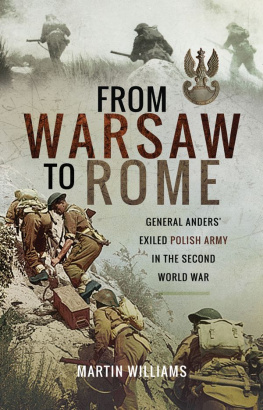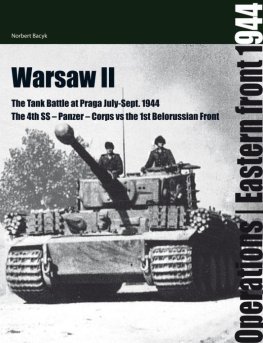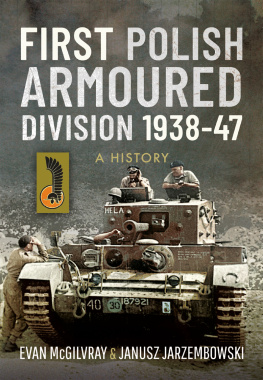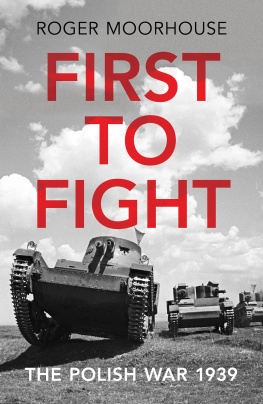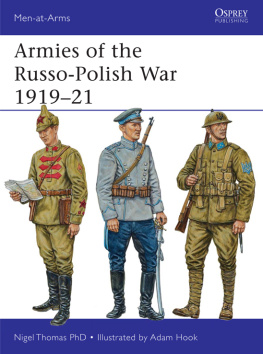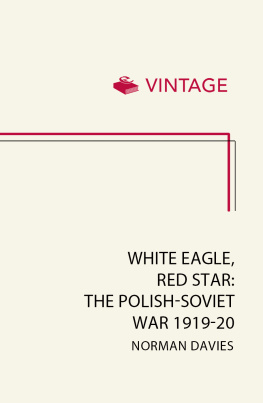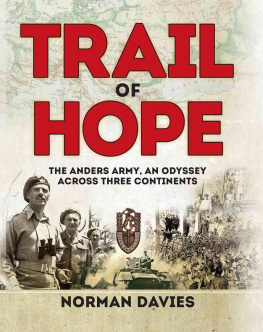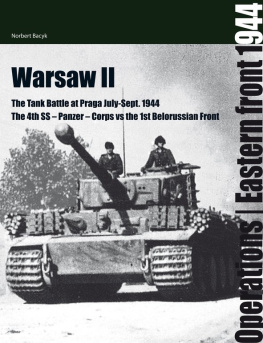
FROM WARSAW TO ROME
FROM WARSAW TO ROME
General Anders Exiled
Polish Army in the Second World War
MARTIN WILLIAMS
First published in Great Britain in 2017 by
PEN & SWORD MILITARY
an imprint of
Pen & Sword Books Ltd
47 Church Street
Barnsley
South Yorkshire
S70 2AS
Copyright Martin Williams, 2017
ISBN 978 1 47389 488 4
eISBN 978 1 47389 490 7
Mobi ISBN 978 1 47389 489 1
The right of Martin Williams to be identified as Author of this work has been asserted by him in accordance with the Copyright, Designs and Patents Act 1988.
A CIP catalogue record for this book is available from the British Library.
All rights reserved. No part of this book may be reproduced or transmitted in any form or by any means, electronic or mechanical including photocopying, recording or by any information storage and retrieval system, without permission from the Publisher in writing.
Pen & Sword Books Ltd incorporates the Imprints of
Pen & Sword Aviation, Pen & Sword Family History, Pen & Sword Maritime,
Pen & Sword Military, Pen & Sword Discovery, Pen & Sword Politics,
Pen & Sword Atlas, Pen & Sword Archaeology, wharncliffe local History,
Wharncliffe True Crime, Wharncliffe Transport, Pen & Sword Select,
Pen & Sword Military Classics, Leo Cooper, The Praetorian Press, Claymore
Press, Remember when, Seaforth Publishing and Frontline Publishing.
For a complete list of Pen & Sword titles please contact
PEN & SWORD BOOKS LIMITED
47 Church Street, Barnsley, South Yorkshire, S70 2AS, England
E-mail:
Website: www.pen-and-sword.co.uk
List of Maps
Polish II Corps, from Warsaw to Rome
Poland 1939
The SovietGerman Front 1941
The SovietGerman Front winter 1941/42
Evacuation of the Polish Army from the USSR, April and August 1942
The Polish Army in the Middle East, September 1942June 1943
Polish II Corps in Palestine and Lebanon, JuneDecember 1943
Polish II Corps arrive in Italy, JanuaryApril 1944
Polish II Corps Sangro River defence, JanuaryApril 1944
Victory at Monte Cassino, 1218 May 1944
Initial Assaults on Hitler Line, 1921 May 1944
Capture of Piedimonte, 2225 May 1944
List of Tables
Polish Independent Carpathian Rifle Brigade 19391942
Development of Principle Formations of the Polish Army in the USSR, August 1941August 1942
Development of the Polish 2 Armoured Brigade
Development of Principle Formations of the Polish Army in the East into the Polish II Corps 19421943
Polish order of Battle in the Mediterranean following General Sosnkowskis Organizational Plan, November 1943
II Corps Organization for the Battle of Monte Cassino
Line of Evacuation for Battlefield Casualties
Introduction
The march from Warsaw to Rome was not a manoeuvre the Polish Army or any other nation had envisaged. Following the defeat of Poland in September 1939 the tens of thousands of soldiers incarcerated in Soviet prisoner-of-war camps were essentially written off as a lost cause. Hitlers invasion of the USSR in June 1941 changed this; these men now represented a vital, potentially decisive addition to the Allied fight against Germany. The struggle to get these Polish soldiers back into action depended on close cooperation between the diplomatic and military missions of Britain, Poland and the USSR. It was to prove a most challenging endeavour.
These three countries, compelled to cooperate through the necessity of war were Allies, not friends. They had nothing in common, no shared ideology or post-war outlook; the relationship was characterized by antipathy, mistrust and open aggression. The only common ground was the objective of defeating Germany. The feat of getting these countries to work together was never realized, even the pacts between them were made individually and not as a tripartite agreement together the three could agree on nothing.
In military circles things were different. The unprecedented effectiveness of Hitlers war machine was obliterating all before it and no nation was able to even slow the onslaught. Something drastic had to be done. The result of the panicked process was a wildly ambitious and risky plan; to release Polish soldiers held in Soviet prisoner-of-war camps, recruit them into a brand new Polish Army to be raised in the Soviet Union, equip them from Britain and then send them to war on the Soviet or Mediterranean front! Amazingly, the scheme did work, not perfectly, but well enough to get tens of thousands of Polish soldiers back in the war and fighting the Germans. That any measure of success was achieved at all was purely down to the dogged determination of the Poles in the Soviet Union to strike back at Hitler, with their dying breath if need be, to wreak vengeance for the plight of their nation. And this they did in good measure.
The creation of the Polish Army in the East and subsequently the II Corps represents the largest non-UK or Dominion fighting force ever raised by Britain; it was a mammoth undertaking without parallel before or since. To grasp the scale of this feat it is helpful to make a brief comparison of troop numbers: the Polish II Corps on 30 April 1945 totalled 83,023

The exiled Polish soldiers lot was a tough one characterized by disease, fatigue, hard choices, isolation and great emotional and political pressure. This cauldron could boil over and led to some scalding arguments and bitter rebukes, notably from Churchill who was perennially frustrated with political infighting amongst the Polish commanders. There was always hope in the story though, characterized by one constant of the Polish Army they were an incredibly tough and ferocious bunch whose spirit to carry on fighting proved to be one of the most outstanding displays of human endurance ever seen. You would not want them as your enemy; as a fighting ally, there could be no better choice.
The following quote from the introduction to Stefan Kleczkowskis 1942 information publication Polands First 100,000 sets a poignant opening for this book: So it is right that British minds should be stirred and their ignorance dispelled by such an account as this of what has been and is being done to regain freedom for Poland... [and that for Polands ongoing fight against Hitler] we and the United Nations owe a historic debt of gratitude. Fully to repay it may be beyond our power. At least we can and should recognize and endeavour to understand it.
This book is an attempt to answer the call from 1942; the debt of gratitude was never repaid, the least we can do now is to appreciate the struggle of our wartime Ally and the role we played in their tragedy, one sadly characterized by ignorance and fear of the Stalinist USSR.
A fitting wartime phrase frequently used by the Poles when describing their struggle was: For our freedom, and yours. Here then, is their story, and ours.
1
The First Blitzkrieg
The summer of 1939 found the pivotal character of this saga, Lieutenant General Wadysaw Anders, in northeast Poland commanding the Nowogrodek Cavalry Brigade, whilst only a few miles away the German Army was massing across the border in East Prussia. Polands military commanders were exasperated by the weeks of political vacillation which had left the nations borders in a flimsy state of readiness only in August had they been permitted to dig in and erect barbed-wire entanglements. The great flat plains of Poland lay open from the German border to the capital of Warsaw. The general mobilization order calling up all reservists was issued on 28 August, but was soon cancelled. This cautious approach was taken at the behest of the British, French and American ambassadors, who were all too aware that in every previous conflict involving Poland the defensive strategy adopted by Polish generals was that of pre-emptive attack. It was hoped that by not antagonizing the Germans unduly, war could be averted even at this late stage.
Next page
